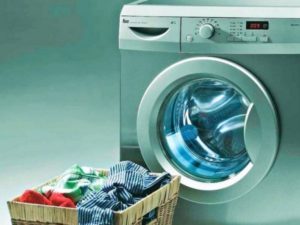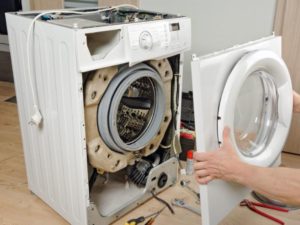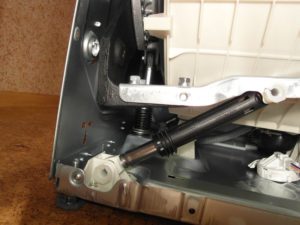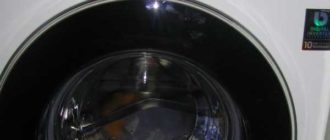 The washing machine is very noisy and bouncing? This is a fairly common problem, any owner of the machine sooner or later faces it. It may be that the washing machine from the beginning makes a lot of noise when wringing, for example, but the noise can also appear during operation - then the causes will be completely different.
The washing machine is very noisy and bouncing? This is a fairly common problem, any owner of the machine sooner or later faces it. It may be that the washing machine from the beginning makes a lot of noise when wringing, for example, but the noise can also appear during operation - then the causes will be completely different.
Unfortunately it is impossible to make the washing machine completely silent, but it is possible to significantly reduce the noise and rumble. So, why is the washing machine very noisy?
The Design of a Washing Machine
Let's first understand the structure of the washing machine and why it creates vibration? The tank is fixed in the body of the washing machine with its system of springs and dampers, a kind of shock absorbers, which just have to reduce the vibration from the centrifugal force of the tank. The motor rotates the drum with a belt and a large pulley, which is often made of duraluminum, and it bends easily. A ballast is often suspended from the drum as a counteracting force to compensate for deflection.
Read more at
The most common causes of noise
After understanding the design, let's look at why the washing machine makes noise.
 The cause may also be the transport bolts, located on the back panel, they are attached to the tank to protect it from damage during transportation. If the bolts are not removed immediately, the main parts begin to wear out much earlier.
The cause may also be the transport bolts, located on the back panel, they are attached to the tank to protect it from damage during transportation. If the bolts are not removed immediately, the main parts begin to wear out much earlier.- Overloading the tank. If according to the instructions, the machine is designed for 5 kg, you should not load laundry in it more than this weight. It all depends on the laws of physics, the manufacturer specifies the maximum load for a reason, because the ballast suspended from the tank can balance the torque, i.e. not let the machine bounce like a rabid one. If you load the laundry above the maximum limit designated by the manufacturer, it will just create high vibration and surges, and the parts of the machine will only deteriorate faster.
- A very common cause also lies in the wrong installation of the washing machine. It is necessary to put the washing machine on a very flat surface, you can even check how flat the machine is by putting a special tool on top - the level. The cause of jumps is that the drum inside the machine, will also tilt because of the uneven surface, and the automation will try to put it back in place, such imbalance will create unnecessary noise.
-
Sometimes it happens that a small object gets caught in the gap between the tank and the drum, you can find it by the sound, turning the drum by hand. And get it out by bending the cuff.
- The worst thing is if something inside the machine is still out of order. Which led to a shift in the center of gravity of the drum. That is why it can happen that, even yesterday a fairly quiet washing machine began to make noise.
It is important, the manufacturers are constantly improving the device washing machine, for example, by installing special sensors, so that the laundry inside was distributed evenly over the drum, which dampens unnecessary vibrations and jumps. Automation simply slows down the speed of rotation.
Solutions
Let's figure out how to fix some problems.
Incorrect installation:
To check quite simply, take a level, a large one, so that it is equal to or larger than the fin of the machine, then the measurements will be as accurate as possible. Use a level to measure all 4 sides of the machine and then adjust the feet on which the machine stands so that the level is level. Of course, it would be better if the floor was level as well, because the feet may twist a little when the machine bounces. You can put a little rubber under each foot to compensate for this defect as well.
Bearing failure
The most common cause of spin noise is bearing failure. It is impossible to avoid this problem, because these parts have a resource of durability and when it is exhausted, the machine starts to make noise. Worst of all is that the failed bearing can entail and leak, then you may need to replace other parts. It's easy enough to check, open the machine and spin the drum, if the rotation is not uniform or the drum spins with difficulty, then the bearings are out of alignment. You can also jiggle the drum up and down, if it moves strongly away from the tank, then the bearings are the cause.
Important: It is very difficult to replace the bearing yourself, it is necessary to disassemble the entire machine, so it is better to contact a master.
Wear of the springs
 Usually in a washing machine there are from 2 to 4 springs. Typically, these are products of thick spring steel, on both sides of such a spring there are bars of not less than 3 mm, with their help, the spring is suspended in the body and it keeps the drum.
Usually in a washing machine there are from 2 to 4 springs. Typically, these are products of thick spring steel, on both sides of such a spring there are bars of not less than 3 mm, with their help, the spring is suspended in the body and it keeps the drum.
With their help, a free rotation of the drum and its slight mixing is achieved, they also compensate the sway of the body when a large centrifugal force occurs. In some cases, the manufacturer can put the springs of poor quality and then the drum at high speed of rotation will deform the springs and hence will move and the washing machine itself.
You can check this way, push the tank by hand, if it quickly fell into place, then the springs are normal, but if the tank wobbles, then it is worth considering the possibility of wear of the springs.
Important: such a replacement on their own also can not be solved, it is better to contact the masters, because they exactly with a special device watching the deviation of the drum from the center and be able to tell exactly stretched one or more springs and replace them.
The damper is out of order.
The role of shock absorbers in the washing machine is performed by the damper. It prevents the drum from bouncing up and down as it rotates. Over time, the damper becomes more and more worn and becomes unusable, as a result, the drum dangles in the body of the washing machine.
The pulley is bent.
And although duralumin is a fairly durable material, it is possible that during operation it could bend or even break off a piece of it.
Important: These two breakages are difficult to detect and even more so to fix, it is better to contact the service center.
Conclusions
Here are the main causes of noises and spikes in the washing machine. If you're wondering why the washing machine started making noise? Then it is worth to go by the method of elimination from the simplest options, to serious breakdowns. If the surface is flat, the feet are adjusted, and there is nothing extra inside the drum, then it is worth to contact the master, perhaps some of the parts inside the machine is out of order.




